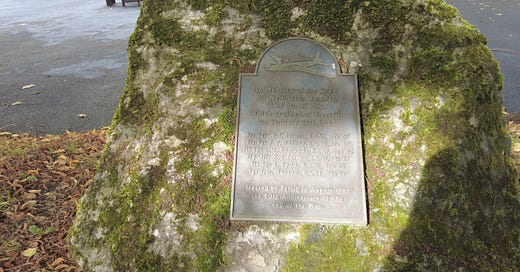The Crash of a WW2 Bomber Memorialised
A trip to the village of Middleton-by-Youlgreave, Derbyshire

Over the years, the Derbyshire hills, have seen a fair number of plane crashes. On a recent trip to the county, I came across a story where villagers wanted to memorialise an air crash that occurred in 1944. This was to remember the passing of 50 years since World War 2. In August 1995 they erected a memorial to the six young men who died in a plane crash on the edge of their village.
We go back to January 21st 1944. A Wellington MK111 Bomber, BJ652/Z was on a training flight. Its crew of six Royal Australian Air Force personnel died upon crashing. The aircraft didn’t burst into flames and it has been said that the fire extinguishers must have been deployed “as otherwise these plans always burn”.
A son of one of the crew was tracked down when the villagers started on their quest to erect the memorial. John Deshon, whose father Frederick Popsham Deshorn was the navigator attended the ceremony for the unveiling of the memorial. John was presented with a fire extinguisher from his father’s aircraft. It had been given to the farmer, upon whose land the plane crashed, by the salvage crew for his efforts in assisting them. Sadly the farmer, who had hoped to present this to John, died two months earlier and his daughter carried out the honour.
What led up to the crash?
We need to remember that flying in those days was a dangerous business even when not under attack. Almost as many died in crashes as in combat.
The Vickers-Armstrong Wellington Bomber was a twin-engined aircraft. It was not designed for night-flying, but in war, needs must. The crew were engaging in a night training exercise.
Initially, the crew were due to fly another aircraft but that had an oil leak, so they switched to BJ652. This plane, too, had a fault which required repair, and their flight was delayed from 1730 to 2017. This meant they were no longer flying with a group of other aircraft on this training mission.
They took off from RAF Church Broughton which is near Derby. Their planned route covered five hundred miles; flying to Haverhill (Suffolk) – Pocklington (East Yorkshire) – Goole (East Yorkshire) – Bury St Edmunds (Suffolk) – Melton Mowbray (Rutland) and returning to Church Broughton.
The original flight plan would have been to Peebles in Scotland but this was curtailed due to expected bad weather.
At 9:40 pm Lichfield transmitted a message instructing the crew to return by 11 pm as the weather front affecting Scotland was expected to arrive across northern England around 11:30 pm. At approximately the same time the crew had recorded their position as 2 miles East of Gainsborough on the northbound leg to Pocklington.
At approximately 9:55 pm, when the aircraft was in the Goole area, the crew turned and headed back to base. Around 15 minutes later an aircraft, that was presumed by the RAF to be BJ652, was noticed by the Royal Observer Corps positions on the edge of Sheffield and at Baslow. The aircraft was heading in a South Westerly direction at about 2,000 feet. Shortly afterwards, the aircraft crashed at Smerril a few miles SW of Bakewell. BJ652 had flown into a rock outcrop and was destroyed.
The crew of BJ652
Lloyd George Edmonds Flight Sergeant RAAF Pilot
Frederick Popsham Deshon Flight Sergeant RAAF Navigator
James Kydd Flight Sergeant RAAF Air Bomber
William Thomas Barnes. Flight Sergeant RAAF Wireless Operator
Keith Jobson Perrett. Flying Officer RAAF Air Gunner
Thomas Dudley Murton Sergeant RAAF Air Gunner
This is a sad story and one that is not unique. Millions have lost their lives in wars and continue to do so. History continues to repeat itself. All six of the crew were buried at Chester (Blacon) Cemetery.
If you want to read the account of John Deshon, whose father, Frederick, was the navigator on BJ652 use this link.
To see my video with a look around the village of Middleton-by-Youlgreave click here.
Thank you for reading and please, if you’re not already, subscribe to Roland’s Travels.





